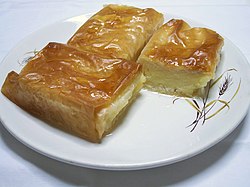Galaktoboureko
Custard-filled pastry From Wikipedia, the free encyclopedia
Galaktoboureko (Greek: γαλακτομπούρεκο, Laz: paponi, Turkish: Laz böreği, Albanian: Qumështor, Arabic: شعيبيات) is a dessert popular in the Balkans, Turkey, and Levant[1][2] of custard baked in filo.[4] Lazi Laz böreği is made with a type of pudding called muhallebi instead of semolina custard. It is popular in the Rize and Artvin provinces in Turkey's Black Sea Region, the indigenous home of Laz people.[1][2] In Albania it is a dessert traditionally prepared during the Orthodox Easter.[5]
This article needs additional citations for verification. (June 2017) |
Preparation
It may be made in a pan, with filo layered on top and underneath and cut into square portions, or rolled into individual servings (often approximately 10 cm (4 in) long). It is served or coated with a clear, sweet syrup. The custard may be flavored with lemon, orange, or rose. Unlike mille-feuille, which it otherwise resembles, the custard is baked with the pastry,[6] not added afterwards.
Laz böreği

Lazi paponi/Laz böreği is made with a variation of the pudding called muhallebi with the inclusion of cornmeal and ground black pepper, instead of semolina custard. It is popular in the Rize and Artvin provinces in the Black Sea Region, indigenous Laz land.[1][2] Its ingredients are thin filo dough, butter, muhallebi, black pepper and simple syrup. Today, it is possible to eat Laz böreği at some restaurants in big cities which serve traditional dishes from the Black Sea region.[7]
See also
References
External links
Wikiwand - on
Seamless Wikipedia browsing. On steroids.

